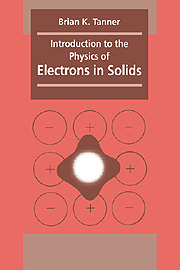
-
Select format
-
- Publisher:
- Cambridge University Press
- Publication date:
- June 2012
- March 1995
- ISBN:
- 9781139167628
- 9780521239417
- 9780521283588
- Dimensions:
- (228 x 152 mm)
- Weight & Pages:
- 0.482kg, 268 Pages
- Dimensions:
- (228 x 152 mm)
- Weight & Pages:
- 0.4kg, 268 Pages
You may already have access via personal or institutional login
Book description
This book aims to introduce the reader to the behaviour of electrons in solids, starting with the simplest possible model, and introducing higher-level models only when the simple model is inadequate. Unlike other solid state physics texts, this book does not begin with complex crystallography, but instead builds up from the simplest possible model of a free electron in a box. The approach is to introduce the subject through its historical development, and to show how quantum mechanics is necessary for an understanding of the properties of electrons in solids. It does not treat the dynamics of the crystal lattice, but proceeds to examine the consequences of collective behaviour in the phenomena of magnetism and superconductivity. Throughout the mathematics is straightforward and uses standard notation. This text is suitable for a second or third year undergraduate course in physics, and would also be suitable for an introductory solid state course in materials science or materials chemistry.
Reviews
"This is a very attractive book from the standpoint of topics covered, style, and level of presentation." M. Coplan, Choice
"...I like this book very much. It provides an ideal introduction to the science behind the ongoing revolutions in microelectronics and microphotonics based on transistors and lasers. The author's enthusiasm for his subject is embodied in a presentation with careful craftsmanship as to principle and disarming charm in selection of materials and examples...designed shrewdly...an excellent choice for an introductory course...Times have changed, and with them the curriculum should change as well. Tanner's book will make changing a pleasure for both students and instructors." J.C. Phillips, Physics Today
Contents
Metrics
Altmetric attention score
Full text views
Full text views help Loading metrics...
Loading metrics...
* Views captured on Cambridge Core between #date#. This data will be updated every 24 hours.
Usage data cannot currently be displayed.
Accessibility standard: Unknown
Why this information is here
This section outlines the accessibility features of this content - including support for screen readers, full keyboard navigation and high-contrast display options. This may not be relevant for you.
Accessibility Information
Accessibility compliance for the PDF of this book is currently unknown and may be updated in the future.


